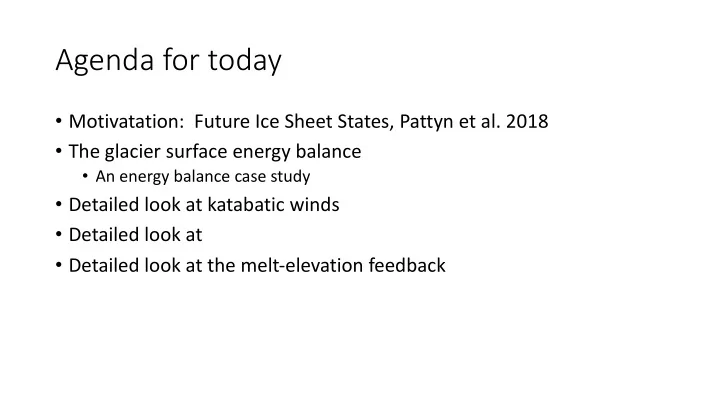

Agenda for today • Motivatation: Future Ice Sheet States, Pattyn et al. 2018 • The glacier surface energy balance • An energy balance case study • Detailed look at katabatic winds • Detailed look at • Detailed look at the melt-elevation feedback
Turbulent sensible and latent heat fluxes • Warm air flowing over ice adds sensible heat to the surface. • Dry air flowing over ice removes moisture and therefore latent heat. • Both of these processes occur through mixing in a turbulent boundary layer. • C E and C H are bulk exchange parameters , u is the velocity, q is the moisture content, T is temperature, rho is density, c is the specific heat, and L is the latent heat.
Haig Glacier, Alberta, Canada, 50.7 N https://backcountryskiingcanada.com/
From Cuffey and Paterson
Field example: Radiant Fluxes 1. Where is the biggest snowfall event? How can you tell? What is the total effect on the energy budget? 2. Why is there anticorrelation between net shortwave and net longwave? 3. Where on the glacier was this site located? 4. Why do both records start during sunny periods? From Cuffey and Paterson
Field Example: Turbulent Fluxes From Cuffey and Paterson
Modeling melting Melting occurs when the glacier surface is 1. At the melting point, and 2. Has a positive net energy budget, The resulting melt rate is, In practice, a “positive degree day” model is most commonly used. From Cuffey and Paterson
Energy Regimes: The coldest climates • Surface temperatures are well below freezing -> A positive energy balance results in heating rather than melting. 1. Why does the sensible heat flux change sign seasonally? 2. What contributes to the radiative energy in the different seasons? 3. Why does the latent heat flux From Cuffey and Paterson increase in the winter?
Recommend
More recommend